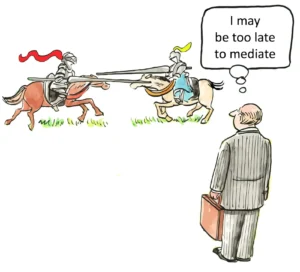Antitrust Enforcement and the Arbitrary and Capricious Standard
The intersection of antitrust enforcement and the arbitrary and capricious standard represents a critical juncture in administrative law, particularly as it relates to the regulation of market competition. This standard, derived from the Administrative Procedure Act (APA), serves as a fundamental check on agency power, ensuring that decisions made by regulatory bodies such as the Federal Trade Commission (FTC) and the Department of Justice (DOJ) are grounded in reasoned analysis and supported by substantial evidence. The application of this standard to antitrust enforcement actions has significant implications for businesses, consumers, and the overall structure of markets in the United States.
The arbitrary and capricious standard requires courts to set aside agency actions that are found to be “arbitrary, capricious, an abuse of discretion, or otherwise not in accordance with law.” This standard of review plays a crucial role in maintaining the balance between effective antitrust enforcement and the protection of businesses from overreaching regulatory action. In the context of antitrust law, this standard is particularly relevant as it governs the judicial review of agency decisions related to mergers, acquisitions, and other potentially anticompetitive practices.
One of the key areas where the arbitrary and capricious standard has been applied in antitrust enforcement is in the review of merger challenges brought by the FTC or DOJ. When these agencies seek to block a proposed merger on antitrust grounds, their decision must withstand scrutiny under this standard. Courts examine whether the agency has provided a reasoned explanation for its conclusion that the merger would substantially lessen competition or tend to create a monopoly. This requires a careful analysis of the agency’s market definition, its assessment of competitive effects, and its consideration of potential efficiencies or procompetitive justifications for the merger.
The application of the arbitrary and capricious standard in merger reviews has led to some notable cases that have shaped the landscape of antitrust enforcement. For instance, in FTC v. Staples, Inc., the court upheld the FTC’s challenge to the proposed merger between Staples and Office Depot, finding that the agency’s analysis of the office supply superstore market was not arbitrary or capricious. The court’s decision emphasized the importance of the agency’s economic analysis and its consideration of real-world competitive dynamics in the relevant market.
However, the arbitrary and capricious standard does not always favor the enforcement agencies. In some cases, courts have found agency actions to be arbitrary and capricious when they fail to adequately explain their reasoning or consider important aspects of the problem. For example, in the case of FTC v. Whole Foods Market, Inc., the D.C. Circuit initially remanded the case to the district court, finding that the FTC’s market definition required further examination. This case highlighted the need for agencies to provide robust economic evidence and clear reasoning to support their enforcement actions.
The arbitrary and capricious standard also plays a significant role in the review of agency rulemaking in the antitrust context. As agencies like the FTC consider adopting new rules or guidelines related to antitrust enforcement, they must ensure that their actions can withstand scrutiny under this standard. This requires agencies to engage in a thorough analysis of the potential impacts of their rules, consider alternative approaches, and respond to significant comments received during the rulemaking process.
One recent example of the application of the arbitrary and capricious standard to antitrust rulemaking is the ongoing litigation surrounding the FTC’s proposed rule to ban non-compete agreements. In July 2024, a federal judge in the Northern District of Texas issued a preliminary injunction against the FTC’s rule, finding that the plaintiffs were likely to succeed on their claim that the rule was arbitrary and capricious. The court’s decision highlighted concerns about the breadth of the rule and the agency’s failure to adequately consider alternative approaches or provide a reasoned explanation for its sweeping prohibition.
The arbitrary and capricious standard intersects with antitrust enforcement in various other contexts as well. For instance, in cases involving allegations of monopolization or abuse of dominant market position, courts may review agency decisions under this standard to ensure that the enforcement action is based on a sound economic analysis and a proper consideration of pro-competitive justifications. This scrutiny helps to prevent overzealous enforcement that could potentially chill legitimate business practices or innovation.
The standard also plays a role in the review of consent decrees and settlements reached between antitrust enforcement agencies and companies accused of anticompetitive behavior. When reviewing these agreements, courts must ensure that the remedies imposed are not arbitrary or capricious, but rather are reasonably calculated to address the competitive concerns identified by the agency. This review helps to maintain the integrity of the enforcement process and ensures that settlements serve the public interest in maintaining competitive markets.
In recent years, the application of the arbitrary and capricious standard in antitrust enforcement has gained renewed attention as agencies have sought to adapt their approaches to the challenges posed by digital markets and platform economies. The rapid evolution of technology and business models in these sectors has led to complex questions about market definition, network effects, and potential anticompetitive practices. As agencies develop new theories of harm and analytical frameworks to address these issues, their actions will likely face scrutiny under the arbitrary and capricious standard.
For example, the FTC’s recent efforts to challenge Facebook’s acquisitions of Instagram and WhatsApp have raised questions about the application of antitrust laws to social media platforms and the consideration of data as a competitive asset. As these cases progress, courts may be called upon to evaluate whether the agency’s theories of harm and proposed remedies are supported by sufficient evidence and reasoning to withstand arbitrary and capricious review.
The arbitrary and capricious standard also intersects with debates about the proper scope of antitrust enforcement and the goals of competition policy. Some scholars and policymakers have argued for a broader interpretation of antitrust laws that would consider factors beyond consumer welfare, such as labor market effects, income inequality, and political power. As agencies potentially shift their enforcement priorities to reflect these broader concerns, their actions may face challenges under the arbitrary and capricious standard, particularly if they represent significant departures from established antitrust doctrine.
The application of the arbitrary and capricious standard in antitrust enforcement also raises important questions about the role of economic analysis and expert testimony in agency decision-making. Courts applying this standard often grapple with complex economic theories and empirical evidence presented by both agencies and defendants. The standard requires agencies to demonstrate that they have considered relevant economic data and theories, but it also affords them some deference in matters of economic judgment within their area of expertise.
This tension between judicial scrutiny and agency expertise is particularly evident in cases involving novel or evolving markets. For instance, in United States v. AT&T Inc., the court’s review of the DOJ’s challenge to the vertical merger between AT&T and Time Warner involved a careful examination of economic models and predictions about the future of the media and telecommunications industries. While the court ultimately rejected the DOJ’s challenge, its analysis highlighted the importance of rigorous economic evidence in meeting the arbitrary and capricious standard.
The arbitrary and capricious standard also plays a crucial role in shaping the procedural aspects of antitrust enforcement. Agencies must ensure that their investigative processes, data collection methods, and analytical approaches are designed to withstand scrutiny under this standard. This often requires agencies to develop robust internal procedures for evaluating competitive effects, considering efficiencies, and documenting their decision-making processes.
For businesses subject to antitrust scrutiny, understanding the implications of the arbitrary and capricious standard is essential for developing effective compliance strategies and responding to agency investigations. Companies engaged in mergers or acquisitions, for example, must be prepared to provide detailed economic analyses and market data to support their positions, anticipating the level of scrutiny that agency decisions will face under this standard.
The application of the arbitrary and capricious standard in antitrust enforcement also has important implications for international cooperation and convergence in competition policy. As antitrust agencies around the world increasingly collaborate on cross-border investigations and enforcement actions, differences in the standards of judicial review can create challenges for achieving consistent outcomes. The arbitrary and capricious standard, as applied in U.S. courts, may differ from the standards used in other jurisdictions, potentially leading to divergent results in cases involving global markets or multinational corporations.
Another area where the arbitrary and capricious standard intersects with antitrust enforcement is in the context of regulatory exemptions and immunities. Various industries and activities may be subject to specific regulatory regimes that provide certain exemptions from antitrust laws. When agencies make decisions about the scope and application of these exemptions, their actions may be subject to review under the arbitrary and capricious standard. Courts must evaluate whether the agency has properly interpreted and applied the relevant statutory provisions and whether its decisions are consistent with the underlying policy goals of both the antitrust laws and the specific regulatory scheme.
The arbitrary and capricious standard also plays a role in shaping the relationship between federal antitrust enforcement and state-level competition policies. While federal agencies like the FTC and DOJ are the primary enforcers of national antitrust laws, state attorneys general also have the authority to bring antitrust actions and enforce state competition laws. When federal agencies make decisions that affect state-level enforcement efforts or preempt state laws, these actions may be subject to review under the arbitrary and capricious standard. Courts must consider whether the federal agency has adequately taken into account federalism concerns and the legitimate interests of states in protecting competition within their borders.
In the realm of intellectual property and antitrust, the arbitrary and capricious standard has been invoked in cases involving standard-essential patents and FRAND (fair, reasonable, and non-discriminatory) licensing commitments. As agencies develop policies and enforcement approaches to address potential anticompetitive conduct in these areas, their actions must be grounded in a reasoned analysis that balances the promotion of innovation with the protection of competition. Courts applying the arbitrary and capricious standard in these cases must navigate complex issues at the intersection of patent law and antitrust policy.
The application of the arbitrary and capricious standard in antitrust enforcement also raises important questions about the role of consumer protection in competition policy. The FTC, for example, has dual mandates in both antitrust and consumer protection. When the agency takes actions that blend these two areas, such as challenging data privacy practices as potential antitrust violations, its decisions may face scrutiny under the arbitrary and capricious standard. Courts must evaluate whether the agency has properly considered the relationship between consumer protection goals and competitive effects in the relevant markets.
As antitrust enforcement continues to evolve in response to new technologies and business models, the arbitrary and capricious standard will likely play an increasingly important role in shaping the boundaries of agency authority. For example, as agencies grapple with issues related to big data, artificial intelligence, and algorithmic competition, their enforcement actions and policy decisions will need to be supported by robust economic analysis and clear reasoning to withstand judicial review under this standard.
The arbitrary and capricious standard also intersects with debates about the proper role of structural versus behavioral remedies in antitrust enforcement. When agencies propose remedies to address competitive concerns, whether in the context of merger reviews or monopolization cases, their choices must be justified under this standard. Courts may examine whether the agency has adequately considered the effectiveness and administrability of proposed remedies, as well as their potential unintended consequences on market dynamics and innovation.
In conclusion, the intersection of antitrust enforcement and the arbitrary and capricious standard represents a critical area of administrative law that has significant implications for market competition, business practices, and consumer welfare. As antitrust agencies navigate complex and evolving markets, their actions will continue to be shaped by the need to provide reasoned explanations and substantial evidence to support their decisions. The ongoing dialogue between agencies, courts, and stakeholders in applying this standard will play a crucial role in ensuring that antitrust enforcement remains effective, fair, and adaptable to the challenges of modern economies.
Website citations:
- https://www.ftc.gov/enforcement/statutes/federal-trade-commission-act
- https://www.justice.gov/atr/antitrust-laws-and-you
- https://www.law.cornell.edu/uscode/text/5/706
- https://www.justice.gov/atr/file/810276/download
- https://www.justice.gov/atr/file/810261/download


















